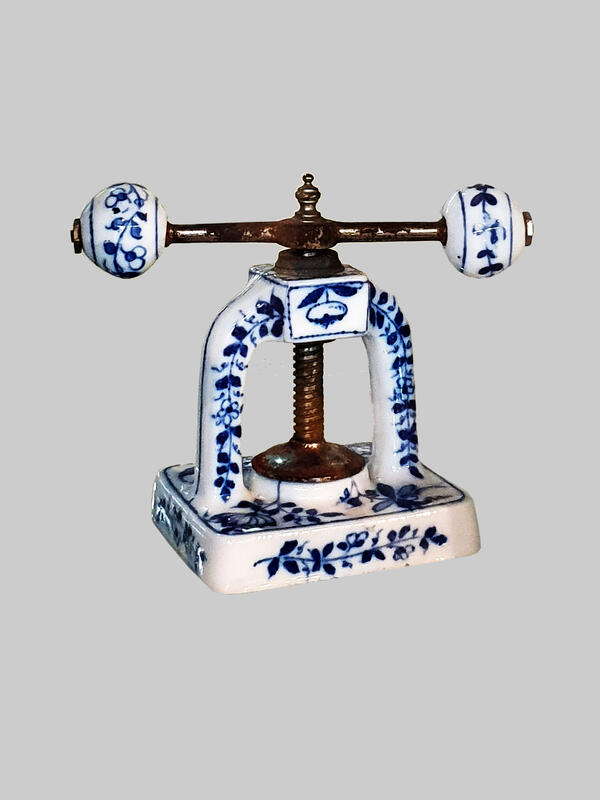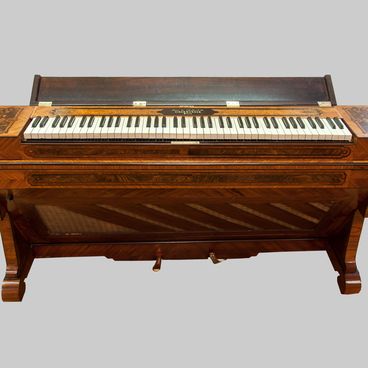The nut cracker with a screw is a unique item from a Blue Onion tableware set. Such a combination of porcelain and metal is rarely found in kitchen equipment. The device was designed for cracking nuts.
The Meissen Manufactory experimented with different pigments for a long time to find the perfect blue paint color. Bright blue was considered to most fitting for the snow-white Meissen porcelain.
After numerous experiments, the artists got what they wanted. It turned out that cobalt produced a lasting bright blue color when oxidized by the firing process. After cobalt deposits had been discovered in nickel ores in the mountainous regions of Saxony, cobalt production increased many times over.
Cobalt-based paint was applied under the glaze, and the pattern became really bright only after the final firing. The Meissen Manufactory mastered this technique in 1717.
The pattern in question was invented by Johann David Kretschmar, one of the artists at the Meissen Manufactory. Kretschmar created the new pattern in 1729, inspired by the repetitions and variations in East Asian cobalt blue patterns. It was originally called ‘blueordinaire’, or ‘regular blue’. The pattern consisted of images of peaches, pomegranates (symbols of fertility), lemons, bamboo sticks, leaves, and blooming lotuses and chrysanthemums. It was perfected by 1739, and we know it in that form to this day.
The ‘Blue Onion’ name appeared by accident. Since the artists did not know what the exotic fruits and flowers they were trying to depict really looked like, Johann Kretschmar’s colleagues jokingly compared the pomegranates in the new pattern to onions. The name came into use in 1850 and stuck, even though the pattern’s main motif is the central image of peonies entwining bamboo stems.
The pattern itself and the paint manufacturing technology quickly became popular. Seeing the success of Meissen porcelain, many factories began to copy the most successful samples. Since the manufactory did not patent its pattern, this process only intensified over time. Well-known manufacturers who also used Meissen’s porcelain pattern included Villeroy & Boch (Germany) and Wedgwood (Great Britain).
The Meissen Manufactory was able to return the exclusive rights to its pattern only in 1886. To protect itself against further counterfeits and imitations, it started marking the Blue Onion porcelain with a stamp depicting crossed swords at the base of a bamboo stem.
Today Meissen is one of the few manufacturers who follow the 270 year old traditions when using the underglaze painting technique.
The Meissen Manufactory experimented with different pigments for a long time to find the perfect blue paint color. Bright blue was considered to most fitting for the snow-white Meissen porcelain.
After numerous experiments, the artists got what they wanted. It turned out that cobalt produced a lasting bright blue color when oxidized by the firing process. After cobalt deposits had been discovered in nickel ores in the mountainous regions of Saxony, cobalt production increased many times over.
Cobalt-based paint was applied under the glaze, and the pattern became really bright only after the final firing. The Meissen Manufactory mastered this technique in 1717.
The pattern in question was invented by Johann David Kretschmar, one of the artists at the Meissen Manufactory. Kretschmar created the new pattern in 1729, inspired by the repetitions and variations in East Asian cobalt blue patterns. It was originally called ‘blueordinaire’, or ‘regular blue’. The pattern consisted of images of peaches, pomegranates (symbols of fertility), lemons, bamboo sticks, leaves, and blooming lotuses and chrysanthemums. It was perfected by 1739, and we know it in that form to this day.
The ‘Blue Onion’ name appeared by accident. Since the artists did not know what the exotic fruits and flowers they were trying to depict really looked like, Johann Kretschmar’s colleagues jokingly compared the pomegranates in the new pattern to onions. The name came into use in 1850 and stuck, even though the pattern’s main motif is the central image of peonies entwining bamboo stems.
The pattern itself and the paint manufacturing technology quickly became popular. Seeing the success of Meissen porcelain, many factories began to copy the most successful samples. Since the manufactory did not patent its pattern, this process only intensified over time. Well-known manufacturers who also used Meissen’s porcelain pattern included Villeroy & Boch (Germany) and Wedgwood (Great Britain).
The Meissen Manufactory was able to return the exclusive rights to its pattern only in 1886. To protect itself against further counterfeits and imitations, it started marking the Blue Onion porcelain with a stamp depicting crossed swords at the base of a bamboo stem.
Today Meissen is one of the few manufacturers who follow the 270 year old traditions when using the underglaze painting technique.



